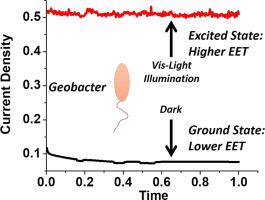Bioelectrochemistry ( IF 4.8 ) Pub Date : 2020-10-06 , DOI: 10.1016/j.bioelechem.2020.107683 Bo Zhang 1 , Hao-Yi Cheng 1 , Aijie Wang 1

|
Dissimilatory metal-reducing bacteria (DMRB) have a variety of c-type cytochromes (OM c-cyts) intercalated in their outer membrane, and this structure serves as the physiological basis for DMRB to carry out the extracellular electron transfer processes. Using Geobacter sulfurreducens as a model DMRB, we demonstrated that visible-light illumination could alter the electronic state of OM c-cyts from the ground state to the excited state in vivo. The existence of excited-state OM c-cyts in vivo was confirmed by spectroscopy. More importantly, excited-state OM c-cyts had a more negative potential compared to their ground-state counterparts, conferring DMRB with an extra pathway to transfer electrons to semi-conductive electron acceptors. To demonstrate this, using a TiO2-coated electrode as an electron acceptor, we showed that G. sulfurreducens could directly utilise the conduction band of TiO2 as an electron acceptor under visible-light illumination (λ > 420 nm) without causing TiO2 charge separation. When G. sulfurreducens was subject to visible-light illumination, the rate of extracellular electron transfer (EET) to TiO2 accelerated by over 8-fold compared to that observed under dark conditions. Results of additional electrochemical tests provided complementary evidence to support that G. sulfurreducens utilised excited-state OM c-cyts to enhance EET to TiO2.
中文翻译:

通过可见光诱导的还原性土壤杆菌的激发态外膜C型细胞色素进行细胞外电子转移
异化金属还原细菌(DMRB)在其外膜中插入了多种c型细胞色素(OM c-cyts),这种结构为DMRB进行细胞外电子转移过程提供了生理基础。使用还原性地球细菌作为模型DMRB,我们证明了可见光照射可在体内将OM c-细胞的电子状态从基态变为激发态。体内兴奋态OM c细胞的存在由光谱证实。更重要的是,与基态对应物相比,激发态OM c-细胞具有更大的负电势,这为DMRB提供了将电子转移至半导体电子受体的额外途径。为了证明这一点,使用涂有TiO 2的电极作为电子受体,我们证明了G.sulfreducens可以在可见光(λ> 420 nm)下直接利用TiO 2的导带作为电子受体,而不会引起TiO 2电荷分离。当硫还原还原杆菌受到可见光照射时,细胞外电子转移(EET)向TiO 2的速率与黑暗条件下观察到的相比,加速了8倍以上。其他电化学测试的结果提供了补充证据,以支持硫还原菌利用激发态OM c-cyts增强EET对TiO 2的作用。











































 京公网安备 11010802027423号
京公网安备 11010802027423号